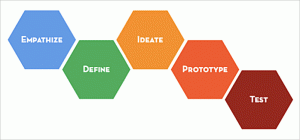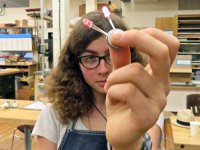Design Thinking and PBL
Design thinking and PBL can bridge what we know and how we innovate. Try combining these two practices as an instructional framework for teaching 21st-century skills.
While project-based learning has existed for decades, design thinking has recently entered the education lexicon, even though its history can be traced back to Herbert A. Simon's 1969 book The Sciences of the Artificial. So why the resurgence of these ideas?
Lately, I have heard teachers and school leaders express a common frustration: "We are _______ years into a _______ initiative, and nothing seems to have changed." Despite redesigning learning spaces, adding technology, or even flipping instruction, they still struggle to innovate or positively change the classroom experience. Imagine innovation as a three-legged stool. Many schools have changed the environment leg, but not the other two legs: the behaviors and beliefs of the teachers, administrators, and students.
Consider this conundrum: much of what we know about teaching comes from 16+ years of observation as students. In no other profession do you spend that much time watching the previous generation before being told to change everything once you take control. Without the framework or scaffolding for that change, it's truly unreasonable to tell educators, "OK, start innovating."
If we look at the science of improvement, systematic change occurs between the contexts of justification (what we know) and discovery (the process of innovation). What if we view PBL and design thinking as possible bridges between those two contexts? What if these frameworks could serve as the justification for discovering new classroom practice?
PBL and 21st-Century Skills
Encouraging students to engage in inquiry, explore real-world contexts, and share their learning lies at the heart of PBL. As an instructional framework, it allows teachers to achieve these goals while still meeting curriculum requirements.
Last spring, Billy Corcoran designed a PBL experience for his fourth-grade class in Old Orchard Beach, Maine. In addition to meeting a multitude of standards, he created an opportunity for his students to make personal connections within their community.
The technology and content requirements for this project had previously existed. The innovation occurred in the shift in behavior and beliefs. He used PBL to:
- Guide his students' problem solving
- Support their collaboration and critical thinking
- Provide voice and choice in how they demonstrated their learning
- Empower them to realize that their contributions to the community make a tangible difference
A project like Billy’s can seem daunting. However, viewing PBL as a process rather than a product means that teachers can fit it within existing curricular objectives, as exemplified by Jodie Deinhammer. Though her science students ultimately work toward larger projects (this year, they will collaborate on a multi-touch book for the Dallas Zoo as well as contribute to an iTunes U course called Life Science), individual classes still address specific skills such as vocabulary acquisition or research. In Jodie's classrooms, students drive their own learning, make real-world connections, and learn that they have a voice to share well beyond the boundaries of the traditional classroom.
Combining Design Thinking and PBL
Creating true PBL experiences is hard! Moving from projects to PBL can feel overwhelming. Design thinking provides another potential form of teacher scaffolding to help craft these experiences.

According to the Stanford d-School process guide, design thinking begins with empathy:
- What do your students consider important?
- Which topics spark their curiosity?
- How might they want to engage with this specific content?
- How might they choose to demonstrate their learning?
Jodie approaches each new year with objectives and goals, but no plans. During the first five days of school, she seeks out her students' curiosities and passions so that she can leverage their interests to drive curriculum throughout the year.
In the next phase of design thinking, you define a problem. In school terms, this could be a curricular unit, a set of skills, or a broader community challenge. Recently, I used design thinking to prepare a professional development workshop. As I read through participants' online discussion posts, I realized the problem: they had never been students with technology. They didn't know what it felt like to learn in a non-traditional classroom, and so they struggled to create one for their own students. I had now defined the problem that this workshop needed to address.
With the problem articulated, start generating ideas. During the ideate phase, the goal is breadth because the answer may not be readily apparent. Many of these ideas then turn into prototypes, simplified versions of potential solutions. As teachers, consider the power of prototyping learning objectives or lesson plans with colleagues. This gives you the freedom to experiment without concerns about failing with students. When ready, produce the final lesson, unit, activity, or even a complete PBL experience.
Christine Boyer, a fifth-grade teacher at Heathcote School in New York, used design thinking to transform her rocketry unit:
Christine worked through the design thinking process to better connect with students, define the problems in her curriculum, test potential solutions with colleagues, and then produce new curriculum plans. Ultimately, she shifted her practice from disseminating procedures to fostering a culture of innovation.
Tony Wagner, author of Creating Innovators: The Making of Young People Who Will Change The World, writes that today's students exist in an "innovation economy." They need to become not only problem solvers, but also problem seekers -- those who can look for solutions in contexts where one never previously existed. As educators, we face a daunting task to bridge our requirements for today with our students' requirements for tomorrow. PBL and design thinking may provide two avenues to scaffold our own thinking and instruction as we move toward innovating our classrooms and schools.
